In a first for William & Mary, Christopher ‘Chuck’ Bailey, professor and chair of the university’s geology department, was recently elected to the presidency of the Geological Society of America. This international-level honor is extremely rare for a professor in an undergraduate department and highlights the prominence and renown of William & Mary’s faculty.
Bailey is the premier expert on Virginia geology. He has mapped huge swaths of the Commonwealth, including many historical sites, and he co-wrote and edited a comprehensive book on the geology of Virginia. Additionally, he has done extensive field work in the American West and internationally.
The GSA presidency is in recognition of his extensive and influential work in the field of geology, his demonstrated ability to explain the importance of geological concepts to the public and the role that he has played in inspiring hundreds of young people to pursue careers in geology. The position consists of one year as president and two more years of service in an executive role. Bailey began his presidency in July.

Founded in 1888, the GSA is an international organization with approximately 22,000 members in 115 countries. Members come from a variety of backgrounds, including academia, government and industry. In addition to publishing peer-reviewed literature, the society organizes scientific meetings and supports geoscientists throughout their careers.
The goals of Bailey’s presidency reflect his teaching at William & Mary. They include attracting, energizing and diversifying membership; communicating research to a wider audience; and connecting with scientists globally through collaborative research and an international field trip program.
“Geology is fundamental to people living on Earth,” said Bailey, “Cool-colored gems and beautiful scenery are things that people usually associate with geology, but geology is the study of the Earth writ large, from the atmosphere, to water, to soil to the solid rock record.”
Bailey points out that elements within rock are necessary for everything from energy sources to modern conveniences like cell phones. Geologists locate those elements and determine the most sustainable ways to extract them. Geologists also study water, including surface water, ground water and coastal processes, as well as how the atmosphere affects conditions at the Earth’s surface.
Public outreach
Throughout his years at W&M, Bailey has sought to communicate effectively with non-scientists. In 2008, he created his W&M blog to describe geological concepts to a wider audience. Additionally, Bailey rarely turns down an invitation to speak about geology to the public, acting as an ambassador for his field whenever requested. Over the years, he has become the go-to expert for Virginia journalists and policymakers when it comes to explanations for a wide array of topics, including earthquakes, mountain formation, geothermal energy and asteroids.
“When I started at William & Mary, I was very focused on structural geology and the research that I did, and trying to advance that science,” says Bailey. “As I’ve gotten older, I’ve taken a broader view, maybe we all do, in the sense that having more people understand planet Earth is a good thing.”
Inspiring young people is part of that, too, and Bailey’s students often sign up for research early in their studies. Those experiences are illustrative of William & Mary’s efforts to offer the most personal education of any public university.
“At the intro level, I tell them about the opportunities that are there for research. And I’m not talking about just doing structural geology research with me,” he said. “Whether they’re interested in dinosaurs, coastal processes, or numerous other areas, we have people in this department who do those things, and we do them really well. Students can get engaged in that research right off the bat.”
Student involvement
Bailey has mentored more than 200 students in research on a wide variety of topics in areas locally, nationally and internationally. In recent years, he and his students have been studying in Oman.
“What makes Oman special is ophiolite, which is a chunk of the Earth’s mantle,” he said. “It’s normally about 30-40 kilometers below us. Tectonic movement has brought it to the surface at that location, which is really rare. Oman is a place that geologists go if they want to understand some of the deep earth processes that normally aren’t visible.”
In addition to increasing geologic knowledge, these trips also allow W&M geologists to build working partnerships with Omani scientists. Students gain experience with a different culture and hone skills that will help them to prepare for careers in the geosciences.
Bailey is also designing an externship program within the geology department that will assist students in career-building.
“We want to recruit students from intro level science courses in this department, and give them opportunities to work with practicing geoscientists,” he said. “These all-expense-paid trips will allow students to make professional connections and see if that particular career suits their interests.”
Assisting past and present students in furthering their careers is just one of many ways that Bailey’s teaching and GSA presidency incorporate the goals and initiatives of William & Mary’s Strategic Plan, Vision 2026.
Many of the Vision 2026 goals and initiatives are longstanding tenets of the W&M geology department, and Bailey notes that his GSA presidency and his achievements at W&M reflect the excellence of the W&M geology community as a whole.
“I think the fact that I was asked to be GSA president is, in part, because of the geology community here at W&M, including my past and present faculty colleagues, our current students and our former students. This position is also because of them,” said Bailey “People outside of W&M know that the geology community here does great things. We have a history and a track record of producing fabulous students who go on to do fabulous things in the earth sciences. And they came from W&M. That doesn’t happen everywhere.”
Bailey’s GSA presidential address can be viewed its entirety here.
Laura Grove, Research Writer

